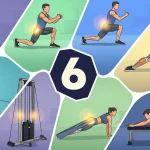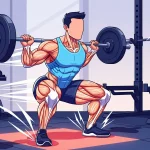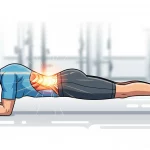Fit People, have you ever struggled to put on a shirt or even walk after an intense workout session? You were excited to finally start a consistent fitness routine, but now you’re second-guessing going back to the gym.
That stiff, aching feeling is more than just muscle fatigue. It’s what’s called DOMS—and no, it doesn’t mean your muscles are “growing.” Let’s dive into the real science behind it so you can understand your body better and prevent unnecessary pain from derailing your progress.
What Is DOMS?
DOMS stands for Delayed Onset Muscle Soreness, the muscle pain that shows up 12 to 48 hours after a workout—especially after doing new exercises, increasing intensity, or lifting heavier weights.
According to the American College of Sports Medicine (ACSM), DOMS occurs when your muscles experience microscopic damage from intense or eccentric movements, like lowering a dumbbell during a squat or walking downstairs post-leg day.
This soreness typically peaks between 24–72 hours and fades within 3–5 days. If you’re already training consistently, you’ll likely experience DOMS less often—your muscles are adapting and becoming more resilient.
Signs of DOMS: More Than Just a Bit Sore
DOMS isn’t just a mild ache. Symptoms can include:
- Deep, lingering soreness 12–48 hours post-exercise
- Stiffness that limits range of motion
- Tenderness when the muscle is touched
- Temporary muscle weakness
- Mild swelling in the affected area
While not dangerous, DOMS can make everyday tasks harder—and it’s one of the most common reasons people skip their next workout.
What Causes DOMS?
DOMS is triggered by muscle stress your body isn’t used to, such as:
- Starting a new workout routine
- Increasing workout intensity or weight
- Doing eccentric movements (like the lowering phase of a bench press)
- Training again after a long break
A study published in the Journal of Applied Physiology found that DOMS is linked to microtears and inflammation in muscle tissue, which also triggers the body’s immune response—causing soreness and tightness.
How to Relieve DOMS (Without Skipping the Gym)
Yes, DOMS hurts. But that doesn’t mean you should take a full break. These strategies can help ease the pain and support faster recovery:
- Gentle Movement
Light walking, cycling, or stretching boosts circulation and helps muscle recovery. - Hot and Cold Compress
Cold therapy is great for early-stage inflammation, while heat can help loosen tight muscles after 48 hours. - Massage or Foam Rolling
Self-massage or foam rolling reduces tension and improves mobility. A study in the Journal of Athletic Training shows it significantly helps reduce DOMS symptoms. - Eat Protein and Anti-Inflammatory Foods
Consume foods rich in protein and omega-3s like salmon, eggs, or nuts to support muscle repair. - Get Enough Sleep
Sleep is when the body recovers and heals—don’t underestimate its power!
How to Prevent DOMS from Coming Back Every Week
Good news: DOMS doesn’t have to be your weekly struggle. Here’s how to reduce the risk:
- Always warm up before working out
- Gradually increase weight or training volume
- Prioritize cool-downs and post-workout stretching
- Maintain proper form—bad technique = more damage
- Train consistently so your body adapts
Conclusion: DOMS Isn’t the Enemy, It’s Your Body Talking
DOMS is your body’s way of saying, “Hey, we’re doing something new here.” It’s not a sign of failure—but also not something you should ignore.
If managed well, DOMS can be a sign of progress, not punishment.
Want to avoid painful recovery and train smarter, not harder? Get help from certified personal trainers at Focus Fit who will guide you through safe, effective routines that respect your limits while pushing your growth. #StayFocs and train smart—because not every rep has to hurt!





